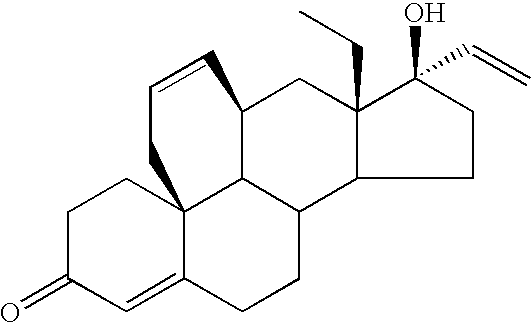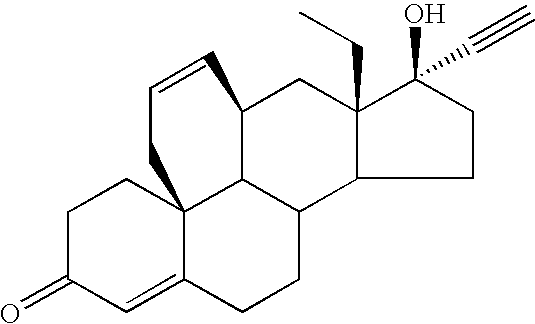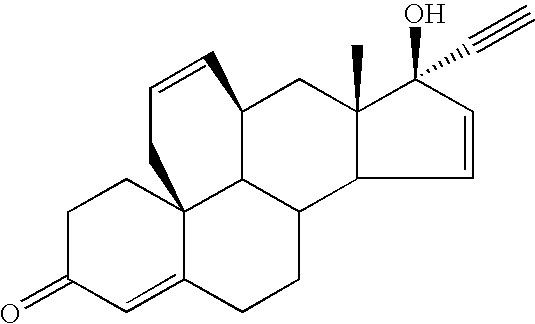Method for screening for progesterone receptor isoform-specific ligands and for tissue-selective progesterone receptor ligands
a progesterone receptor and isoform-specific technology, applied in the field of tissue-selective progesterone receptor ligand screening, can solve the problems of inability to identify tissue-selective pr ligands, inability to develop new generations of progestins to improve their selectivity profile, and inability to disclose any method used specifically to identify such ligands, so as to reduce coc's and hrt undetected effects, protect both
- Summary
- Abstract
- Description
- Claims
- Application Information
AI Technical Summary
Benefits of technology
Problems solved by technology
Method used
Image
Examples
example 1
[0089] Method for Screening for Isoform-Specific PR Ligands
[0090] The method for screening for isoform-specific PR ligands according to the present invention is carried out with first and second SK-N-MC cells stably transfected with a plasmid expressing the hPR-A (first cells) or the hPR-B (second cells) and the LUC reporter gene linked to the hormonally responsive MTV promoter. A detailed description of how the cell lines according to the invention and used in this Example may be obtained is given in Example 5.
[0091] The cells are cultured in Minimum Essential Medium with Earl's Salts (S-MEM, without L-glutamine; Gibco BRL, no. 21090-022), supplemented with 10% fetal calf serum (FCS), penicillin 100U / streptomycin 100 .mu.g / ml (Biochrom, no. A2213), L-glutamine 4 mmol / l (Gibco BRL, no. 25030-024), sodium pyruvate 1 mmol / l (Biochrom, no. L0473) and 1.times. non-essential amino acids (Biochrom, no. K0293) at a temperature of 37.degree. C. and in an atmosphere of 5% carbon dioxide.
[009...
example 2
[0155] Bioassay on Proliferatin / Differentiating Effects in the Rat Mammary Epithelium
[0156] The object of this test is to evaluate the effect of progestins (PR ligands) on the development of the mammary gland, in particular on the formation of terminal end buds in the mammary gland in estrogen primed rats.
[0157] Premature female rats (Wistar Han, SPF) are ovariectomized at the age of 21 days, 4 to 6 days before treatment start. The animals are treated for 6 days with standard estrogen (estrone, 70 .mu.g / kg) and the test ligand (application volume: 0.1 ml / 50 g body weight; vehicle: benzylbenzoate / castor oil (1+4 v / v); subcutaneous). Control groups are e.g.: vehicle, estradiol without progestin, estradiol together with a known progestin, e.g. R5020. After the 6 day treatment the animals are killed with carbon dioxide.
[0158] For the whole mount staining, animals are shaved in the left abdominal inguinal mammary region, which is cut from the body together with the skin. For the histolog...
example 3
[0173] Pregnancy Maintenance Test in Rat
[0174] In rats, castration induces termination of pregnancy. Progestins (combined with estrogens) are capable of maintaining pregnancy in castrated animals. However, the degree of pregnancy maintenance in castrated rats is optimal only in a defined dose range. Therefore, higher as well as lower doses generally induce a weaker effect. Accompanying treatment with defined doses of estrone (E.sub.1) increases the pregnancy maintaining effect of progestins.
[0175] Pregnant rats (Wistar Han, SPF) of 190 to 220 g (5 to 8 animals per dose) are ovariectomized on day 8 of pregnancy, 2 hours after the first substance administration. From day 8 to day 14, rats are daily treated with test compound in combination with a standard dose of E.sub.1. One day later, animals are killed with carbon dioxide. For each animal, the number of living and dead fetuses is determined according to the heartbeat of the embryos. In case of empty uteri, the number of implantatio...
PUM
| Property | Measurement | Unit |
|---|---|---|
| temperature | aaaaa | aaaaa |
| pH | aaaaa | aaaaa |
| area | aaaaa | aaaaa |
Abstract
Description
Claims
Application Information
 Login to View More
Login to View More - R&D
- Intellectual Property
- Life Sciences
- Materials
- Tech Scout
- Unparalleled Data Quality
- Higher Quality Content
- 60% Fewer Hallucinations
Browse by: Latest US Patents, China's latest patents, Technical Efficacy Thesaurus, Application Domain, Technology Topic, Popular Technical Reports.
© 2025 PatSnap. All rights reserved.Legal|Privacy policy|Modern Slavery Act Transparency Statement|Sitemap|About US| Contact US: help@patsnap.com



